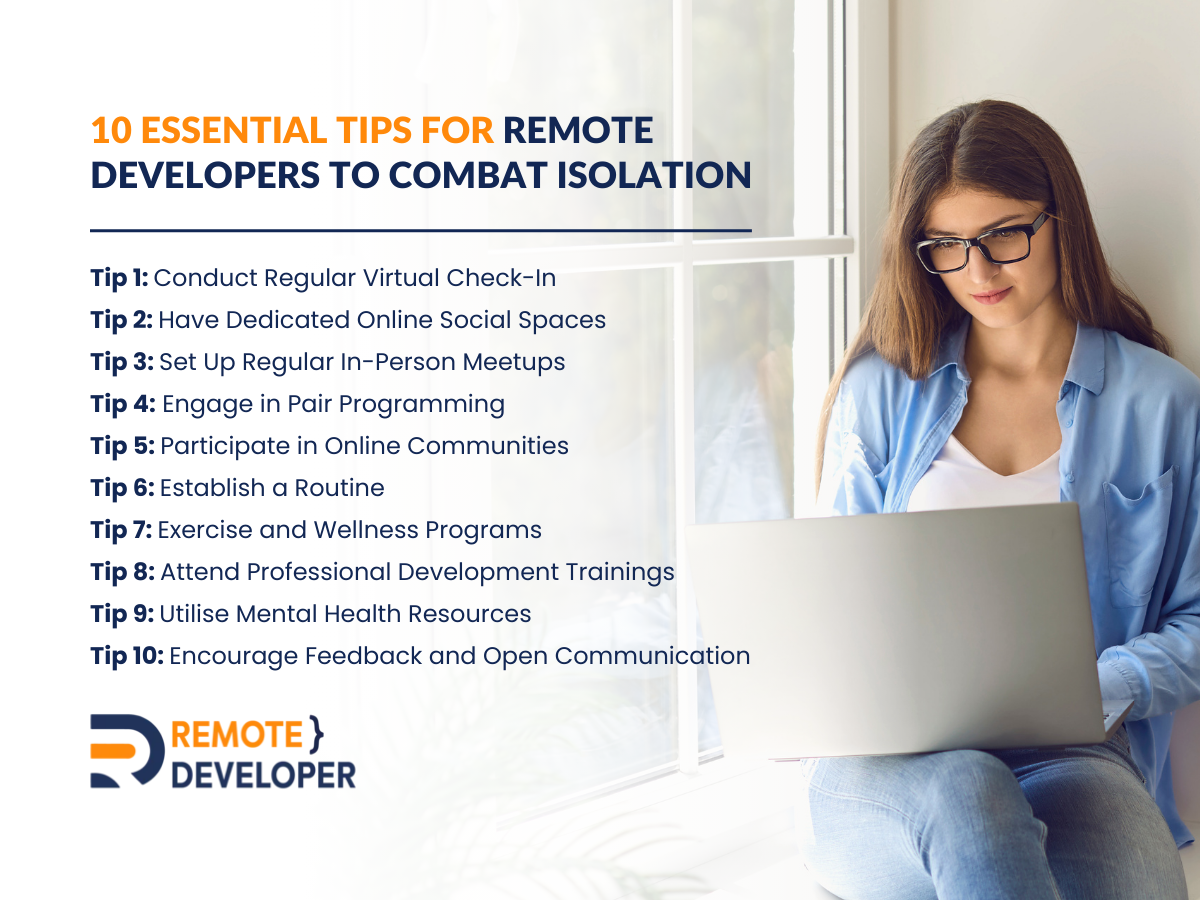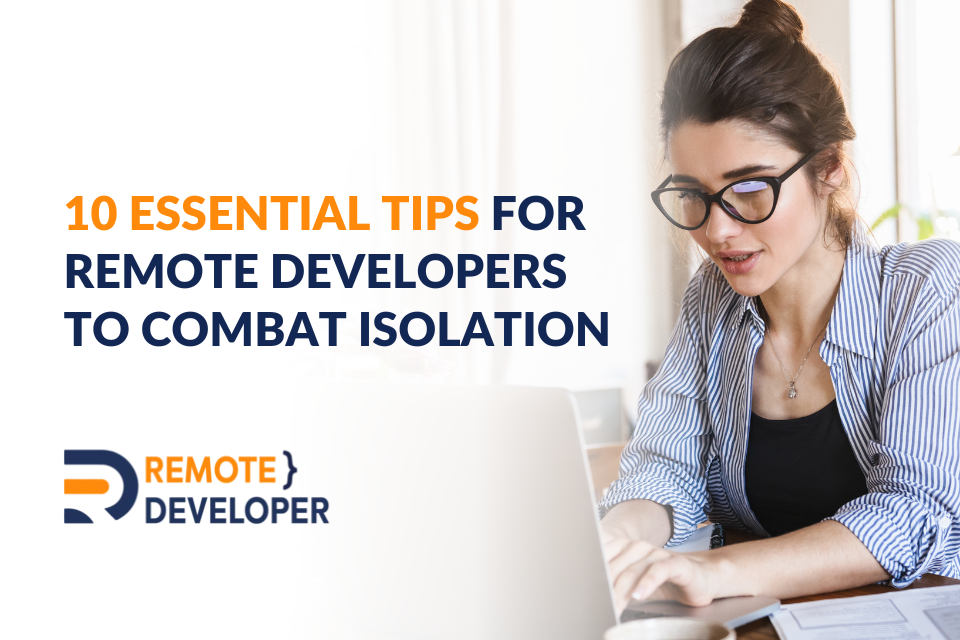The rise of remote work has transformed how software developers engage with their teams. While remote work provides numerous advantages, it can also present unique challenges. Amongst them is the risk of isolation.
Working alone, away from a physical office environment, can sometimes lead to feelings of disconnection, loneliness, and even a decline in mental well-being. As remote developers, finding ways to maintain social interaction, stay connected with colleagues, and protect your mental health is essential.
So, in this article, we will explore 10 actionable tips to avoid remote job isolation, foster stronger connections with their peers, and improve both their work experience and overall well-being.

Tip 1: Regular Virtual Check-Ins
Scheduling regular virtual check-ins with your team is a great way to avoid remote work isolation. These can take the form of daily stand-ups, weekly team meetings, or one-on-one sessions with your manager or colleagues. The key here is consistency—establishing a regular cadence of face-to-face interactions, even if they’re virtual, helps create a routine and gives you a chance to connect on both a professional and personal level.
Virtual check-ins also serve as a reminder that, even though you’re physically alone, you’re part of a larger team working towards common goals. These meetings can help address any feelings of disconnection by allowing for real-time feedback and collaboration. Video calls, in particular, are valuable because they allow you to see facial expressions and body language, adding a human touch to the conversation that email or messaging tools might lack.
Tip 2: Dedicated Online Social Spaces
Not every conversation needs to be work-related. In fact, one of the best ways to mimic the informal interactions of an office setting is by creating virtual social spaces where team members can chat about non-work topics. Platforms like Slack or Discord offer the perfect medium for setting up casual “water cooler” channels dedicated to topics like hobbies, pets, or weekend plans.
These spaces foster camaraderie, allowing remote developers to bond over shared interests outside of work. Employees can discuss the latest tech trends or organise virtual game nights; these social spaces create an opportunity for informal interaction that helps break the monotony of remote work.
Tip 3: Set Up Regular In-Person Meetups
While remote work is predominantly virtual, nothing beats the connection that comes from in-person interactions. If your team is geographically close or has the budget for travel, organising regular in-person meetups can significantly reduce feelings of isolation when working from home. These face-to-face gatherings strengthen bonds and build trust in ways that virtual meetings can’t always replicate.
In-person meetups provide an opportunity to avoid remote work isolation. It allows you to socialise outside the confines of work. This deepens relationships and creates lasting connections that translate into better collaboration when you return to working remotely.
For teams that are fully distributed across different countries or time zones, consider attending industry conferences together, which can serve as both professional development and social engagement.
Tip 4: Engage in Pair Programming
Pair programming is an excellent way for developers to avoid remote work isolation and collaborate with coworkers. In pair programming, two developers work together on the same piece of code, with one writing code and the other reviewing it in real time. This technique fosters constant communication, allows for knowledge sharing, and helps developers stay engaged with each other throughout the workday.
Pair programming also offers an opportunity for less experienced developers to learn from their peers, building both technical skills and relationships. Regularly pairing with different team members ensures that you interact with a variety of colleagues, strengthening your connection to the team.
Beyond the technical benefits, pair programming can also provide emotional support by replicating the collaborative environment of a traditional office, reducing feelings of isolation.
Tip 5: Participate in Online Communities
While your immediate team is your first point of contact for collaboration, it’s also important to connect with the broader developer community. Participating in online communities can be a great way to reduce isolation and expand your professional network. Forums like Stack Overflow, GitHub discussions, Reddit’s programming communities, and even Twitter are excellent platforms where developers can ask questions, share insights, and contribute to the wider tech community.
Joining these communities offers remote developers a sense of belonging and purpose, as they engage with like-minded individuals who share similar challenges and interests. Contributing to open-source projects, attending virtual coding meetups, and engaging in discussions on social media can help you stay connected to the industry, feel part of something bigger, and combat feelings of loneliness.
Tip 6: Establish a Routine
One of the biggest challenges for remote workers is the lack of structure that comes with working from home. Without the external cues of commuting or fixed office hours, it’s easy to let your workday bleed into your personal time, leading to burnout and, ironically, further isolation. Establishing a routine helps combat this by creating boundaries between work and personal life.
A well-structured routine gives your day a sense of purpose and stability. Start your day with a morning routine, just as you would if you were heading to an office—whether that involves having breakfast, exercising, or reading the news. Set specific work hours, take regular breaks, and make sure to step away from your computer at the end of the day.
Tip 7: Exercise and Wellness Programs
Physical activity is one of the best antidotes to the sedentary nature of remote work. Working from home makes it easy to spend hours in front of the computer without moving, which can negatively impact mental and physical health.
As such, incorporating regular exercise into your day not only improves your physical well-being but also boosts your mood and reduces stress. In fact, many companies now offer virtual wellness programs, such as guided meditation sessions, yoga classes, or fitness challenges, to encourage employees to stay active. Even if your company doesn’t provide these programs, there are plenty of free online resources and apps that can help you incorporate wellness into your routine.
Setting aside time for daily physical activity will leave you feeling more energised and mentally refreshed, helping you avoid the mental fatigue and isolation that can come from being cooped up indoors all day.
Tip 8: Professional Development
Professional growth and development are crucial for maintaining motivation and staying connected in the tech industry. Remote work offers a unique opportunity to pursue continuous learning through webinars, online courses, coding boot camps, and certifications.
Many professional development programs, such as coding challenges or hackathons, are naturally collaborative, allowing you to interact with fellow developers, mentors, and instructors. Participating in these activities helps avoid remote work isolation and stay engaged with the tech community. Moreover, learning new technologies and techniques keeps your work exciting and challenging, preventing the isolation that can come from feeling stagnant.
Tip 9: Mental Health Resources
Remote work can take a toll on mental health, especially if you’re feeling isolated or disconnected from your colleagues. It’s essential to proactively take care of your mental well-being by using available mental health resources. Many companies offer Employee Assistance Programs (EAPs), which provide confidential counseling services, mental health hotlines, and wellness programs to support employees.
If your company doesn’t offer mental health resources, external services, such as online therapy platforms or mental health apps, are available. These tools can be invaluable in managing stress and avoiding remote work isolation. Additionally, practicing mindfulness, meditation, and breathing exercises can help you stay grounded and cope with feelings of isolation.
Tip 10: Feedback and Open Communication
Open communication is key to a healthy remote work environment. Remote developers should feel empowered to ask for regular feedback from their supervisors and peers to ensure they are on the right track and aligned with the team’s goals. Feedback sessions also provide a space to discuss any challenges related to remote work, such as feelings of isolation or disconnection.
Encouraging open communication helps create a supportive and inclusive work culture where everyone feels heard. This not only improves job satisfaction but also strengthens relationships within the team. Through this, remote developers can address any issues early on, ensuring they feel supported and connected throughout their remote work journey.
Conclusion
Remote work is a growing trend, but it doesn’t have to mean isolation. Try implementing these 10 tips and watch your remote developers enhance their social connections, improve their mental health, and find joy and fulfillment in their work.
Feeling isolated? Contact us for more resources and support to thrive in your remote work environment.

